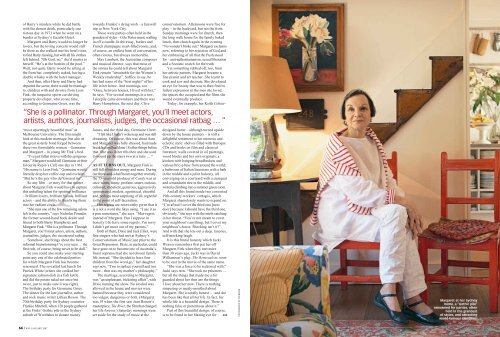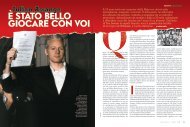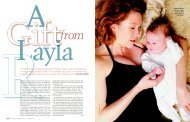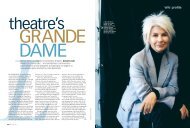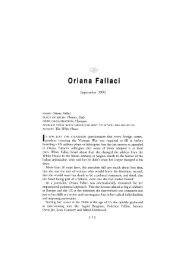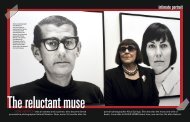Margaret Fink - David Leser
Margaret Fink - David Leser
Margaret Fink - David Leser
You also want an ePaper? Increase the reach of your titles
YUMPU automatically turns print PDFs into web optimized ePapers that Google loves.
of Barry’s minders while he did battle<br />
with the demon drink, particularly one<br />
riotous day in 1971 when he went on a<br />
bender at Sydney’s Gazebo Hotel.<br />
<strong>Margaret</strong> and Barry would no longer be<br />
lovers, but the loving concern would still<br />
be there as she walked into his hotel room<br />
to find Barry missing, but with all his clothes<br />
left behind. “Oh God, no,” she’d mutter to<br />
herself. “He’s at the bottom of the pool.”<br />
Well, not quite. Barry would be sitting at<br />
the front bar, completely naked, having a<br />
double whisky with the hotel manager.<br />
And then, after Harry and Barry had<br />
departed the scene, there would be marriage<br />
to, children with and divorce from Leon<br />
<strong>Fink</strong>, the turquoise sports car-driving<br />
property developer, who at one time,<br />
according to Germaine Greer, was the<br />
“most upsettingly beautiful man” at<br />
Melbourne University. The film might<br />
look at this modern marriage, but also at<br />
the great sisterly bond forged between<br />
these two formidable women – Germaine<br />
and <strong>Margaret</strong> – in young Mr <strong>Fink</strong>’s bed.<br />
“I’ve just fallen in love with this gorgeous<br />
man,” <strong>Margaret</strong> would tell Germaine at their<br />
favourite Repin’s Café one day in 1961.<br />
“His name is Leon <strong>Fink</strong>.” Germaine would<br />
literally drop her coffee cup and exclaim,<br />
“But he’s the guy who deflowered me”.<br />
So any film – or story for that matter –<br />
about <strong>Margaret</strong> <strong>Fink</strong> would have to capture<br />
this unfailing talent for spotting brilliance<br />
– brilliant lovers, brilliant friends, brilliant<br />
actors – and the ability to then bring them<br />
into her radiant circle.<br />
“She runs one of the few remaining salons<br />
left in the country,” says Nicholas Pounder,<br />
the former second-hand book dealer and<br />
friend to both Barry Humphries and<br />
<strong>Margaret</strong> <strong>Fink</strong>. “She is a pollinator. Through<br />
<strong>Margaret</strong>, you’ll meet actors, artists, authors,<br />
journalists, judges, the occasional ratbag<br />
… Somehow, she brings about the best<br />
informal brainstorming I’ve ever seen … the<br />
first rule, of course, being never to be dull.”<br />
So you could also make your starting<br />
point any one of the celebrated parties<br />
for which <strong>Margaret</strong> <strong>Fink</strong> has become<br />
renowned. The so-called last lunch for<br />
Patrick White (where she cooked her<br />
signature salmon dish in a fish kettle<br />
and did the potato salad not once but<br />
twice, just to make sure it was right).<br />
The birthday party for Germaine Greer.<br />
The dinner for the late journalist, author<br />
and rock music writer Lillian Roxon. The<br />
70th birthday party for Sydney couturier<br />
Frankie Mitchell, when 120 people gathered<br />
at the <strong>Fink</strong>s’ Gothic pile in the Sydney<br />
suburb of Woollahra to donate money<br />
A<br />
towards Frankie’s dying wish – a farewell<br />
trip to New York City.<br />
These were parties often held in the<br />
grandest of styles – Cole Porter music wafting<br />
in off a candle-lit driveway, butlers and<br />
French champagne in art-filled rooms, and,<br />
of course, an endless hum of conversation,<br />
often riotous, but always memorable.<br />
Max Lambert, the Australian composer<br />
and musical director, says that most of<br />
the stories he could tell about <strong>Margaret</strong><br />
<strong>Fink</strong> remain “unsuitable for the Women’s<br />
Weekly readership”. Suffice to say, he<br />
has had some of the “best nights” of his<br />
life in her home. And mornings, too.<br />
“Once, between houses, I lived with her,”<br />
he says. “For several mornings in a row,<br />
I sleepily came downstairs and there was<br />
Barry Humphries, the next day, Clive<br />
James, and the third day, Germaine Greer.<br />
“I felt like I hadn’t woken up and was still<br />
dreaming. Of course, this was about 8am<br />
and <strong>Margaret</strong> was fully dressed, had made<br />
breakfast and had done 18 other things before<br />
that. She was in her 60s then and she used<br />
to bound up the stairs two at a time … ”<br />
AS IT TURNS OUT, <strong>Margaret</strong> <strong>Fink</strong> is<br />
still full of restless energy and more. During<br />
our three-and-a-half hours together recently,<br />
the 73-year-old producer of Candy was at<br />
once warm, funny, profane, smart, curious,<br />
cultured, impatient, generous, aggressively<br />
opinionated, modest, egotistical, cheerful<br />
and, perhaps most surprising of all, regretful<br />
to the point of self-laceration.<br />
Her regrets are noteworthy given that it<br />
is a not a word she likes using. “I use it as<br />
a pun sometimes,” she says. “Mar-regret,<br />
instead of <strong>Margaret</strong>. But I suppose in<br />
honesty I do have some regrets. I’m sorry<br />
I didn’t get more out of my parents.”<br />
Both of them, Dixie and Jack Elliot, were<br />
fine singers who had met at Sydney’s<br />
Conservatorium of Music just prior to the<br />
Great Depression. Dixie, in particular, could<br />
have gone on to become one of Australia’s<br />
finest sopranos had she not chosen family<br />
life instead. “She decided to have four<br />
children from the word go,” her daughter<br />
says now. “Two to replace yourself and two<br />
more – that was my mother’s philosophy.”<br />
The marriage, according to <strong>Margaret</strong>,<br />
was “an unpleasant, bickering affair”, with<br />
Dixie running the show. No alcohol was<br />
allowed in the house and movies were<br />
banned because they were considered<br />
too vulgar, dangerous or both. (<strong>Margaret</strong><br />
was 19 when she first saw Jean Renoir’s<br />
masterpiece, The River, the film that changed<br />
her life forever.) Saturday mornings were<br />
set aside for the study of music at the<br />
conservatorium. Afternoons were free for<br />
play – in the backyard, but not the front.<br />
Sunday mornings were for church, then<br />
the long walk home for the family baked<br />
lunch, then church again in the evening.<br />
“No wonder I broke out,” <strong>Margaret</strong> exclaims<br />
now, referring to her rejection of God and<br />
her embracing of all that the Push stood<br />
for – anti-authoritarianism, sexual liberation<br />
and a Socratic search for the truth.<br />
Yet something rubbed off, too, from<br />
her artistic parents. <strong>Margaret</strong> became a<br />
fine pianist and art teacher. She learnt to<br />
cook and sew and decorate. She developed<br />
an eye for beauty that was to then find its<br />
fullest expression in the men she loved,<br />
the spaces she occupied and the films she<br />
would eventually produce.<br />
Today, for example, her Keith Cottier-<br />
“She is a pollinator. Through <strong>Margaret</strong>, you’ll meet actors,<br />
artists, authors, journalists, judges, the occasional ratbag … ”<br />
designed home – although turned upside<br />
down by the house painters – is still a<br />
delightful testament to her interests and<br />
eclectic style: shelves filled with Baroque<br />
CDs and books on film and classical<br />
literature; walls covered in oil paintings,<br />
wood blocks and her own originals; a<br />
kitchen with hanging breadbaskets and<br />
various bric-a-brac from around the world;<br />
a bathroom of Italian limestone with a bath<br />
in the middle and a juliet balcony, all<br />
converging on a courtyard with a cumquat<br />
and a mandarin tree in the middle, and<br />
wisteria climbing into a summer green room.<br />
And all this found inside two converted<br />
19th-century workers’ cottages, which<br />
<strong>Margaret</strong> shamelessly wants to expand on.<br />
“I’m afraid I covet the third one [next<br />
door] because I should have the third one,<br />
obviously,” she says with the mirth catching<br />
in her throat. “You’re not meant to covet<br />
your neighbour’s anything, but I covet my<br />
neighbour’s house. Shocking isn’t it?”<br />
And with that she lets out a deep, raucous,<br />
self-mocking laugh.<br />
It is this brutal honesty which Jacki<br />
Weaver remembers first put her off<br />
<strong>Margaret</strong> <strong>Fink</strong> when they met more<br />
than 30 years ago. Jacki was in <strong>David</strong><br />
Williamson’s play, The Removalists, soon<br />
to be cast in the movie of the same name.<br />
“She was a force to be reckoned with,”<br />
Jacki says now. “She took no prisoners …<br />
but all the things that made me a bit<br />
guarded about her then are the things<br />
I love about her now. There is nothing<br />
simpering or mealy-mouthed about<br />
<strong>Margaret</strong>. She is totally honest … and she<br />
has been like that all her life. In fact, her<br />
whole life is a beautiful design. There is<br />
nothing false or pretentious about it.”<br />
Part of this beautiful design, of course,<br />
is to be found in her blazing eye for<br />
PHOTOGRAPHY BY TIM BAUER.<br />
<strong>Margaret</strong> at her Sydney<br />
home, a “Gothic pile”<br />
renowned for parties, often<br />
held in the grandest<br />
of styles, and attracting<br />
world-famous identities.<br />
66 | WW JANUARY 2007 WW JANUARY 2007 | 67


